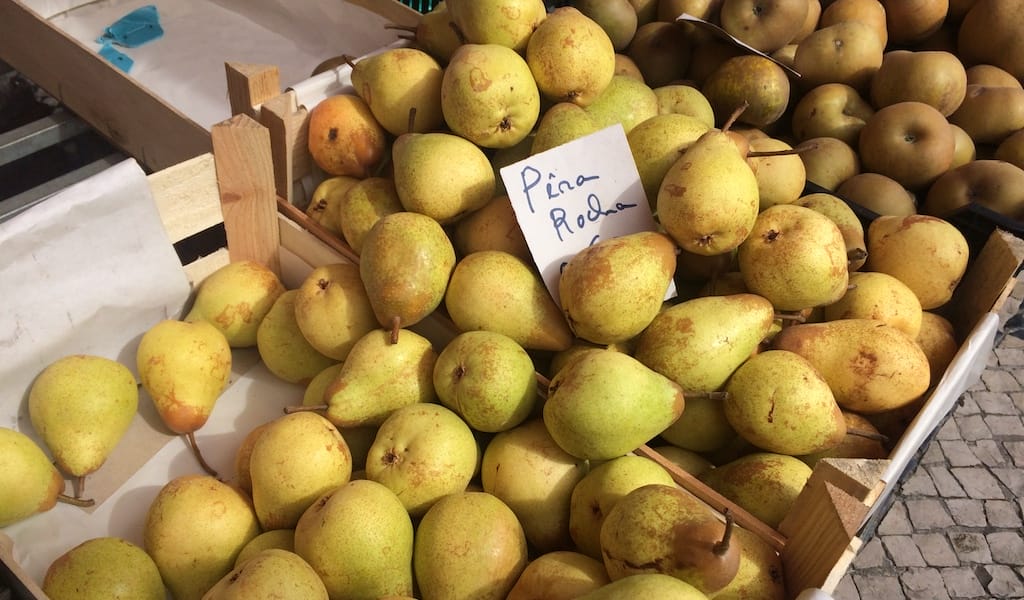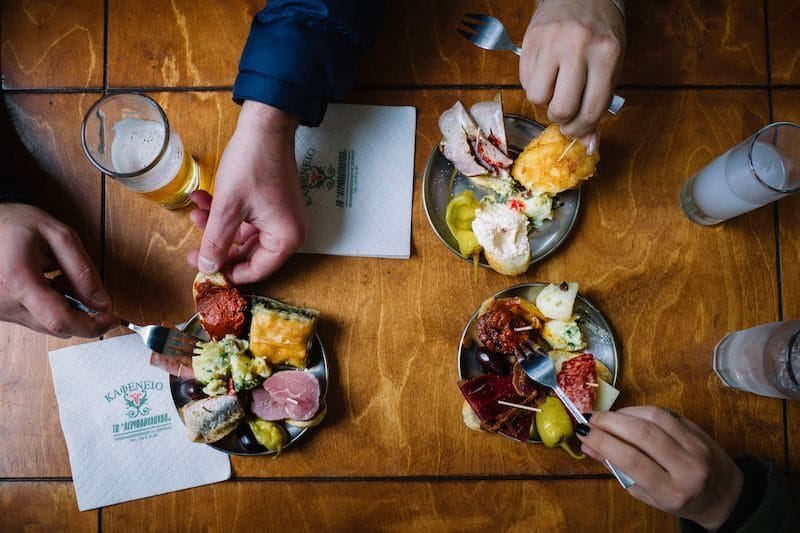As the highway speeds out of Lisbon northward, the pastel apartment blocks of greater Lisbon’s northern sprawl give way to plots of farmland. It’s a road with no distinction, one not unlike countless others leaving cities elsewhere.
Around 80 kilometers from Lisbon, the highway passes into the region of Oeste; although not readily apparent, Oeste is a place of great distinction. That becomes clearer a bit farther down the road, where on the side of a warehouse the words “Rocha Mundial” are printed beside a giant likeness of the region’s claim to fame, a green pear with light brown spots.
Oeste is “Rocha World” as the sign says and this is worthy of one’s attention because the pêra rocha is perhaps the tastiest pear in the world – they should be sold by the individually-wrapped piece in Japanese department stores – and it only grows to its truest form on the trees right here. Eating one of these pears is a singular experience, its properties an expression of this region’s soil and climate. To eat one is to experience Oeste, transforming this nondescript landscape on either side of the A8 highway into a place of great importance.
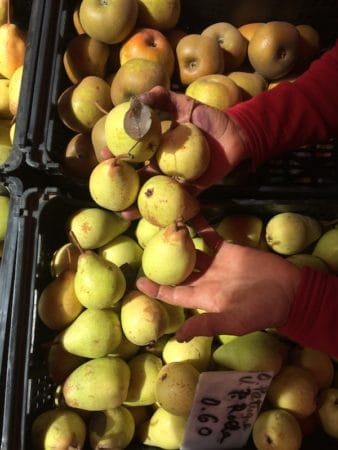 Further up the road is the casbah of the rocha, Caldas da Rainha, which holds a daily market in the town square, drawing farmers in from the surrounding countryside and buyers from all over central Portugal who are lured in by the sweet and juicy pears.
Further up the road is the casbah of the rocha, Caldas da Rainha, which holds a daily market in the town square, drawing farmers in from the surrounding countryside and buyers from all over central Portugal who are lured in by the sweet and juicy pears.
“This pear is one of the best fruits we have in Portugal,” says Miguel Laffan, chef of the Michelin-starred L’AND Vineyards. “It reminds me of a light violet perfume and at the same time it tastes a lot of green, it has a very interesting culinary acidity.”
This pear, the pera rocha de Oeste, one of 150 Protected Designation of Origin (PDO) products in Portugal, is exported widely and successfully due to its unusually long shelf life. “With refrigeration, pears picked in late August and September are still in the markets in May,” says Carla Simões from Frutalvor, a cooperative of producers in the region. Simões reports that 12,000 tons of these pears are harvested each year and 60 percent are exported, mainly to the U.K. and Brazil. Some farms in the region work on an industrial scale but most remain small plot farms, run by the families we encountered in the market of Caldas da Rainha.
Dona Fernanda Maria, 64, stooped and squinting, runs fruit-stained fingers over a pile of pears like a jeweler, chattering, always in motion. She has been working her fruit stand in this market since she was eight years old. As a child she rode in on a donkey towing a load from her family’s fields in the nearby village of Antas. Now, her husband works the land and seasonal workers help with the harvest. She’s in good spirits, enjoying the bounty of what she says is the best harvest she can remember.
“This pear is one of the best fruits we have in Portugal.”
To her left and right are 40 or so more stands selling fruits and vegetables, all of which seem to be experiencing their perfect moment. Our eyes dart from the nugget heads of garlic strung up to rigid beans piled and frilly topped jars of jam carefully arranged. But the real stars of this show are the pears.
Over toward the kiosk where shoppers with wheeled bags sidle up to sip a bica (coffee) in the sun, we met Ricardo Nazaré, 15, smiling in braces before a pile of pears. If Dona Fernanda has been around the longest, Ricardo is probably the market’s most recent arrival. This is his first month on the job, and his grandfather Joao Felix lovingly watches over his work. Ricardo’s not sure if he’ll follow his grandfather’s path as a farmer, or his father’s as an engineer. “I’m into all sorts of stuff,” he says. But in the summer, like so many students in Oeste, he picks pears earning €45 per day, he reports, “lunch included.” So maybe there’s hope for the next generation of farmers around here.
Many of these pears, blessed with that long shelf life, will travel the same road we came in on back to Lisbon. They’ll turn up in the fruit stands of Mercado da Ribeira where Lisboetas will buy them and squirrel them away into the refrigerator where they will last for weeks, if not months. But many more will make their way into the hulking stainless steel sobremesa (dessert) display cases of tascas, local neighborhood restaurants. Aside from the ubiquitous television set, the sobremesa case, with its ingeniously angled mirrors that give a view of the desserts from all sides, is the focal point of a tasca’s dining room.
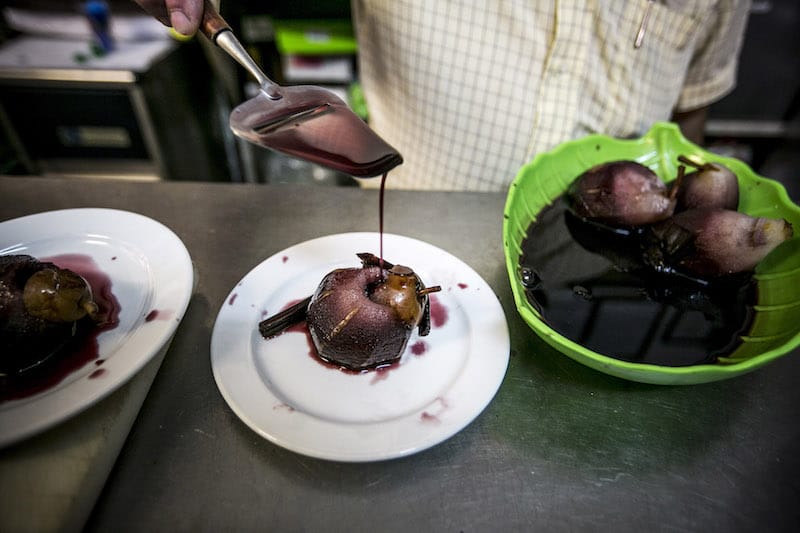
In one such tasca down in Lisbon’s Santos district, we tracked down rocha pears from Oeste. Adega dos Arcos is a no-frills sort of place, where local shopkeepers may wander in for a quick drink at the bar or sit down for a lunch of fried fish. The room is quartered off by wide stone arches, and the walls and counter are covered with framed photos and bric-a-brac. We order the pêras bêbedas, pears poached in red wine; the dessert arrives still warm.
Sitting in a pool of sweet red wine gravy, the pear is stained crimson and smells of cinnamon. We work our way through the dessert, which is mouth-puckeringly sweet, to the center of the fruit, where the unique identity of the pêra rocha is still vaguely identifiable. As appealing as the dessert is, the truth is that no human intervention – aside from picking it and washing it – is going to make that pear any better than it already is, and tascas around town know this. The dessert menu at Adega dos Arcos includes a list of single fruits on offer, including those divine pears. We wish we’d kept our order simple, something the Portuguese do extremely well.
Pêras bêbedas might even be something of an anomaly. Whether it’s a barnacle scraped off of a rock down in the Algarve or a bundle of bay leaves from Madeira, there’s a deep respect for the quality and character of foods that prohibits unnecessary fiddling around in the kitchen. So what you get, in the best-case scenario, is a minimal intervention that thrusts the goodness of the materials forward at maximum velocity.
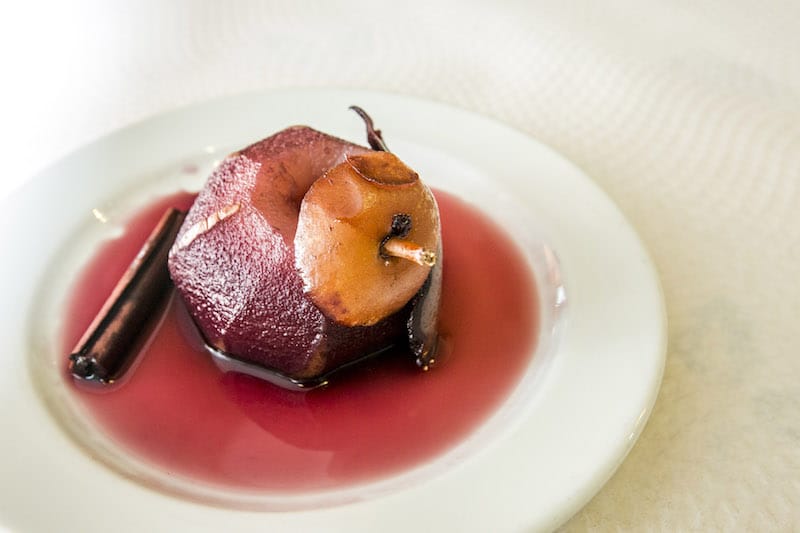
Boiled potatoes, crushed with a light smack on the counter just before being served, have verve. Sardines, not even gutted, kissed on the grill, are a cause for celebration. This is the standard expected and upheld, even in the most humble of restaurants. That’s the trick of traditional Portuguese cuisine and why it is so hard to replicate, as a concept, outside of the Portuguese world. Keeping it really simple is, unfortunately, not so hip.
Chomping down on a piece of fruit might not sound like a sophisticated way to end a lunch with your colleagues, but give it a try, particularly if you see a pile of small spotted pears in the cooler. You can likely find a fine pêra rocha in a supermarket in Leeds or a tasca in Porto throughout the year, but the ones plucked fresh from the branch, sold by ladies like Dona Fernanda in the market of Caldas da Rainha, are something special. If you find yourself in Portugal around harvest time, consider making Oeste a destination.
Editor’s Note: Autumn has officially arrived, and with it comes an updated batch of Fall-Winter Eatineraries, CB’s seasonal self-guided food itineraries for travelers. The 2017-2018 Lisbon Eatinerary has the inside scoop on where to go for everything from the richest feijoada to the tastiest empada in town.
This article was originally published on October 12, 2017.
Published on October 02, 2023
Related stories
February 19, 2021
AthensMuch as we may love the kitchen, and while the lockdown has given us plenty of time to experiment with old and new recipes, there does come a moment when the cook needs a meal off. Whether it’s because you have neglected to shop, have run out of inspiration or simply hanker for a dish…
May 13, 2021
AthensQuick bite: On this food tour in Plaka, we will explore the district's culinary diamonds in the touristy rough while at the same time getting a sense of how this ancient district shaped the growth of modern Athens. The historic Plaka district might be one of Athens’ most popular tourist destinations, but there’s another part…
January 12, 2015
Shanghai | By Monica Liau
Shanghai[Editor's note: We're sorry to report that Bamboo Sichuan has closed.] The temperature has officially fallen off the register, and there are days when Shanghai seems bleak indeed, the cumulus clouds of winter hugging the skyline uncomfortably close. It’s times like these when we look to western China for inspiration, and nothing but Sichuanese-style roasted fish…







































